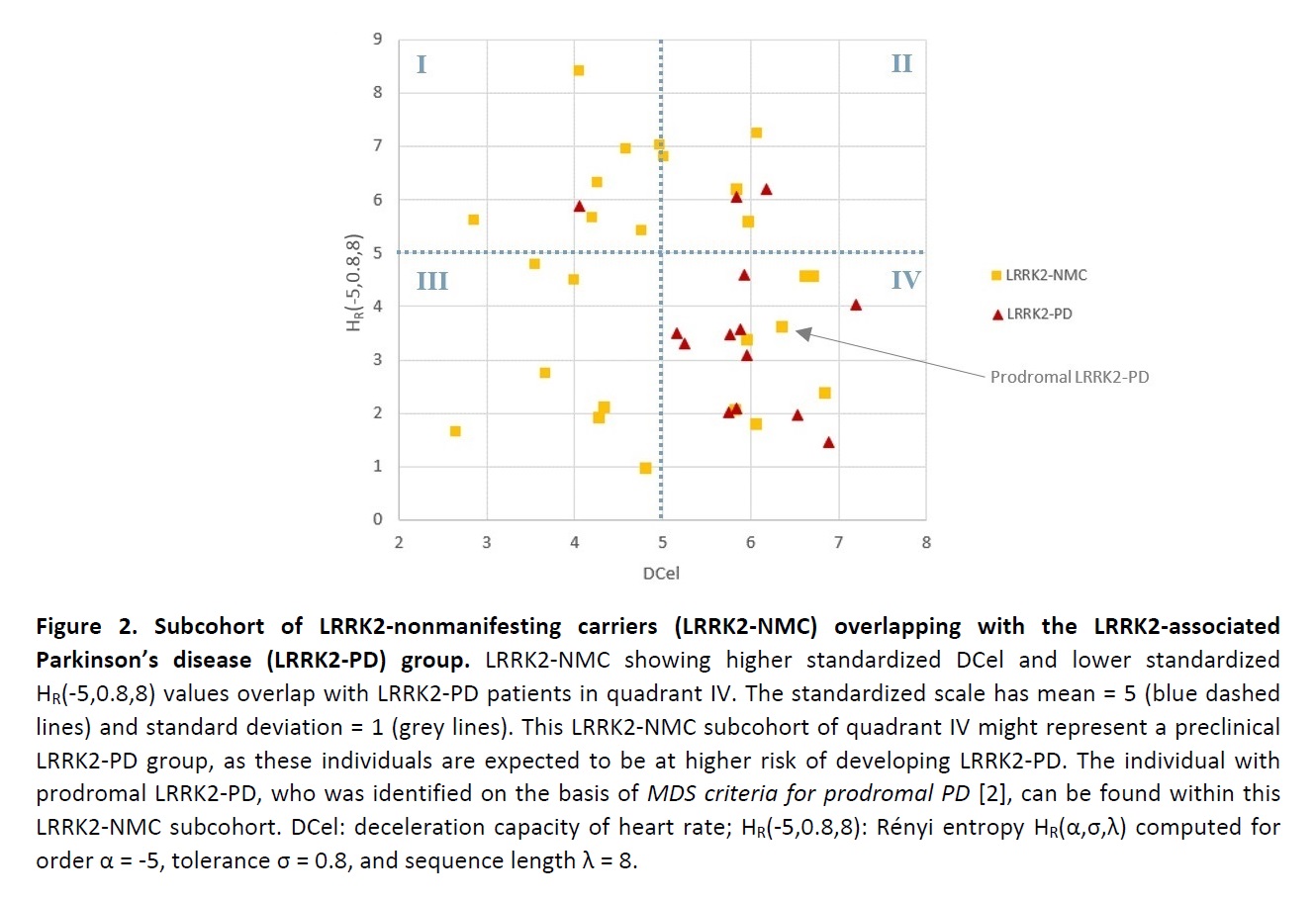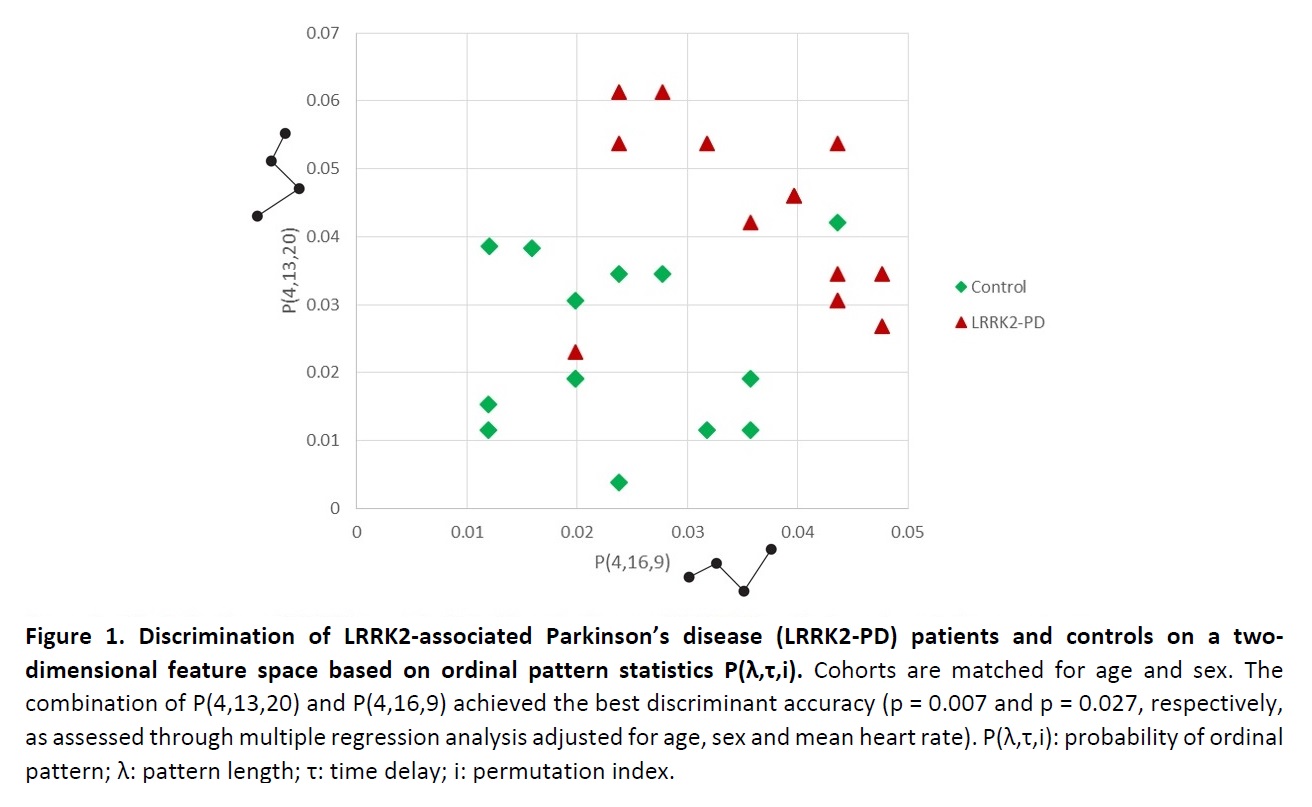Session Information
Date: Monday, October 8, 2018
Session Title: Parkinson's Disease: Non-Motor Symptoms
Session Time: 1:15pm-2:45pm
Location: Hall 3FG
Objective: Assessment of cardiac autonomic function through standard and novel features of heart rate variability (HRV) in individuals who carry the G2019S mutation in the LRRK2 gene.
Background: Cardiac autonomic dysfunction manifests as a reduction in HRV in idiopathic Parkinson’s disease (iPD). Previous studies have found no change for standard HRV measures in LRRK2-associated PD (LRRK2-PD) or LRRK2-nonmanifesting carriers (LRRK2-NMC) [1], but novel HRV features, such as permutation entropy and Rényi multiscale entropy (RE), have not been investigated. Therefore involvement and timing of cardiac autonomic alterations over the course of PD remain unclear in LRRK2 mutation carriers.
Methods: Several HRV features from the time and frequency domains, as well as nonlinear analysis, were explored in 14 LRRK2-PD patients, 25 LRRK2-NMC, 32 related non-carriers, 20 iPD patients, and 27 healthy controls. Linear regression modelling was applied to compare HRV measures after controlling for age, sex, mean heart rate (HR), and disease duration. Classification functions were estimated by linear discriminant analysis and validated in an independent subsample.
Results: HRV measures of vagal modulation were significantly increased in LRRK2-PD patients compared to controls (Deceleration Capacity of HR: p = 0.006), whereas global HRV measures were significantly increased compared to iPD (8th Central Moment: p < 0.001). LRRK2-PD patients also showed a significant increase in the irregularity of HR dynamics, as quantified by RE, compared to controls (p = 0.002) and iPD patients (p < 0.001). A pattern of periodic tachycardia was also prevalent in LRRK2-PD patients. Classification functions based on HRV ordinal pattern statistics (OPS) permitted the identification of LRRK2-PD patients with 93% accuracy (p < 0.001) (figure 1). An increased beat-to-beat variability and irregularity of HR dynamics was also found in the LRRK2-NMC compared to controls (figure 2).
Conclusions: An increased beat-to-beat variability and irregularity of HR dynamics was found to be a feature of preclinical, prodromal and clinical LRRK2-PD, suggesting a potentially increased cardiac vagal drive in this genetic form of PD. RE was the most relevant feature, revealing cardiac chronotropic alterations in LRRK2-PD, which have not been observed previously. OPS allowed a highly accurate identification of LRRK2- PD patients.
References: 1. Visanji, N. P., et al., (2017). Heart rate variability in leucine-rich repeat kinase 2-associated Parkinson’s disease. Mov Disord 32(4): p. 610-614. 2. Berg, D., et al., (2015). MDS research criteria for prodromal Parkinson’s disease. Mov Disord 30(12): p. 1600-11.
To cite this abstract in AMA style:
C. Carricarte Naranjo, C. Marras, N. Visanji, D. Cornforth, L. Sanchez-Rodriguez, B. Schuele, S. Goldman, M. Estévez Báez, P. Stein, A. Lang, H. Jelinek, A. Machado García. Listen to the heart: Do loud vagal rhythms disharmonize the autonomic symphony in Parkinson’s disease patients with the LRRK2 mutation? [abstract]. Mov Disord. 2018; 33 (suppl 2). https://www.mdsabstracts.org/abstract/listen-to-the-heart-do-loud-vagal-rhythms-disharmonize-the-autonomic-symphony-in-parkinsons-disease-patients-with-the-lrrk2-mutation/. Accessed March 6, 2025.« Back to 2018 International Congress
MDS Abstracts - https://www.mdsabstracts.org/abstract/listen-to-the-heart-do-loud-vagal-rhythms-disharmonize-the-autonomic-symphony-in-parkinsons-disease-patients-with-the-lrrk2-mutation/


